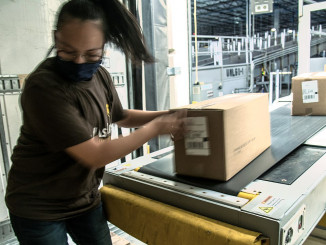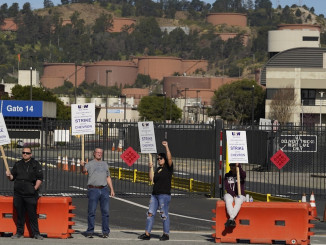
On Thursday, Sep. 14, two unions representing about 60,000 railroad workers announced that they have reached a tentative contract agreement, and have called off what would have been the first national railroad strike in 30 years.
For months the Biden administration has been supporting the rail companies in trying to stop a strike from happening. Back in July when the original strike deadline loomed, Biden appointed a Presidential Emergency Board (PEB) in order to postpone the deadline by 60 days and come up with a deal that would have been favorable to the rail companies. It was clear even then that the power of workers to disrupt the economy and the flow of profits to the capitalists was of paramount importance to the government.
The main issues for rail workers have been sick time, scheduling, and staffing. Over the past six years, rail companies have cut the workforce by 30 percent (about 45,000 workers), running the trains with severely dangerous understaffing while imposing increased restrictions on workers’ time off. As a result, currently workers have no official days off for sick time, and are forced to be on-call 24/7, and have no set schedule. Workers can work over 80 hours a week, and can be away from home over 100 hours per week.
Due to these huge cuts to the workforce, rail companies have made record profits over the years, paying out $196 billion to shareholders since 2010.
After a month of negotiations, Biden’s emergency board tried to get the workers to agree to a contract that included a 24% wage increase over five years while doing nothing to address the demands for paid sick leave, more time off, and staffing shortages.
Without hesitation, the rail companies supported the emergency board’s recommendations, and since then most national railroad unions have reached tentative agreements with the companies. But two unions (the Brotherhood of Locomotive Engineers and Trainmen (BLET), and the SMART Transportation Division), which represent 60,000 workers (about half the workforce), did not agree to the recommendations and were ready to strike starting Friday, September 16.
As the strike deadline approached, and rail companies were facing losses of an estimated two billion dollars per day, rail companies increased their pressure on the workers, and tried to stir up anger from the population at the workers. Amtrak began cancelling all long-distance passenger trains for Thursday, September 15. And freight companies halted all shipments of fertilizer and other chemicals necessary for agriculture while trying to blame the rail workers.
On Wednesday, two days before the strike deadline, large corporations representing the $7.4 trillion wholesale-distribution industry called on Congress to prevent a rail strike from “further disrupting the supply chain.” In response, Republican Senators tried to pass a Congressional resolution that would have imposed the recommendations of Biden’s emergency board onto the unions. But Senator Bernie Sanders was able to block it from passing as he and other Democrats thought that a deal could be reached to avoid the strike.
With the strike deadline approaching and no deal yet reached, the Biden administration maneuvered their way into the negotiations, headed by Biden’s Secretary of Labor, Marty Walsh, and later joined by Biden himself. It was from this closed-door meeting that union leaders announced that a tentative agreement had been reached. And Biden, so far, has gotten to play hero and appear as if he stopped the strike from happening, just in time for the mid-term elections.
But so far workers have not been able to see much of the details of the new tentative agreement. According to In These Times, President of the BLET union, Dennis Pierce, said it “is probably going to take three to four weeks” to get the tentative agreement into the hands of rank-and-file workers to review and vote on.
But if a tentative agreement has been reached that addresses the concerns of the rank-and-file, which were previously ignored by Biden’s emergency board, why wouldn’t the full details of the agreement be made public right away?!
The official press release from the unions says that rail workers will receive only one additional paid day off, and will be able to “take time away from work to attend to routine and preventive medical care, as well as exemptions from attendance policies for hospitalizations and surgical procedures.” But no further details have been made available to workers yet.
And, according to an article with Railway Age, the tentative agreement does not mention anything about the harsh “attendance policies” or “more predictable work schedules” because those will be left up to “local bargaining.” And the press release from the National Carriers’ Conference Committee, which represents the big rail companies, only mentions the original wage increases proposed by the emergency board and makes no mention of the harsh attendance policies that workers have demanded to be changed. And there appears to be nothing about changes to the dangerous understaffing policies.
So it is no surprise that rank-and-file workers have expressed on social media and in interviews frustration and doubts over the announced tentative agreement. Some have expressed, as one worker put it, that “it’s a garbage deal. Everyone hates it so far. It does nothing for me. I’ll vote no. This has been a complete waste of time.”
Given the profits of the rail companies, there is no question rail workers deserve a much better contract than what has been laid out in the tentative agreement. It seems the tentative agreement does nothing to address staffing, and little to address some of the workers’ other major concerns. It seems to be a little better than the earlier recommendations from the emergency board, but not much.
The question now is whether the pressure of the Biden administration and the rail companies, as well as the seal of approval from the union leadership, has been enough to get rail workers to accept the agreement. Or will rail workers reject it, and vote no, demand more, go on strike, and use their power even more? We shall see.




